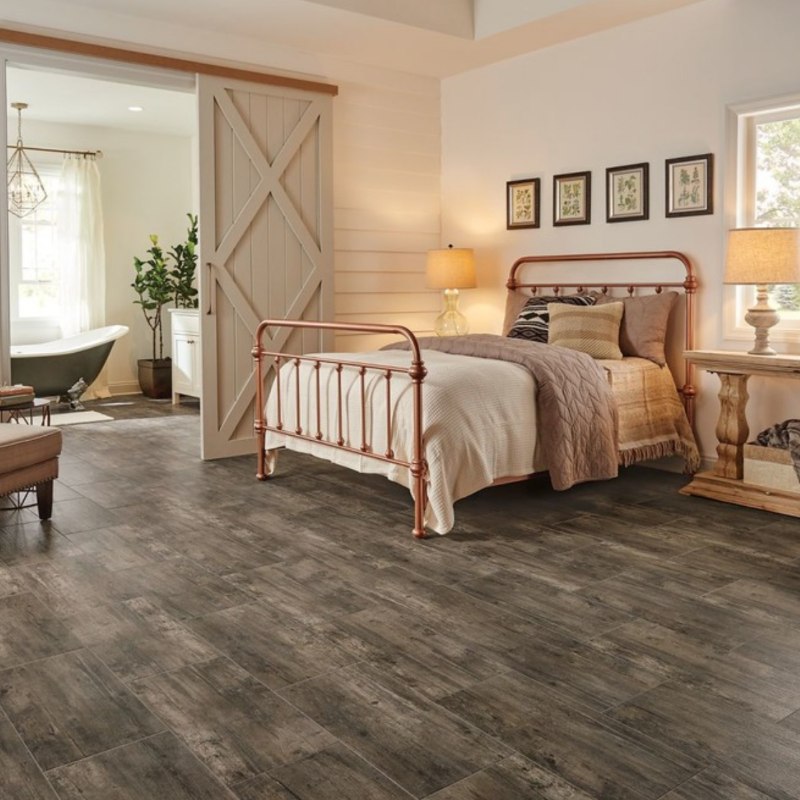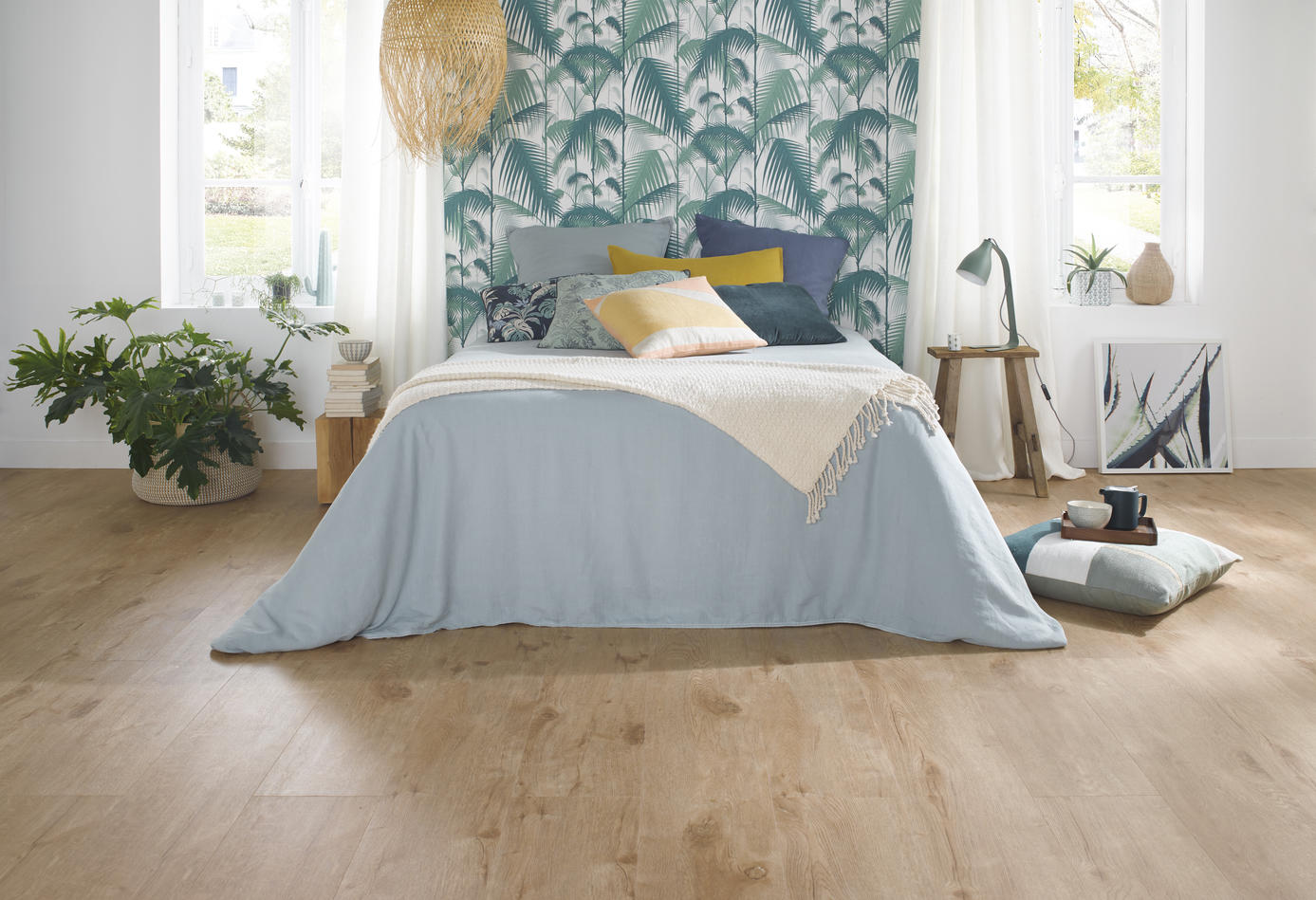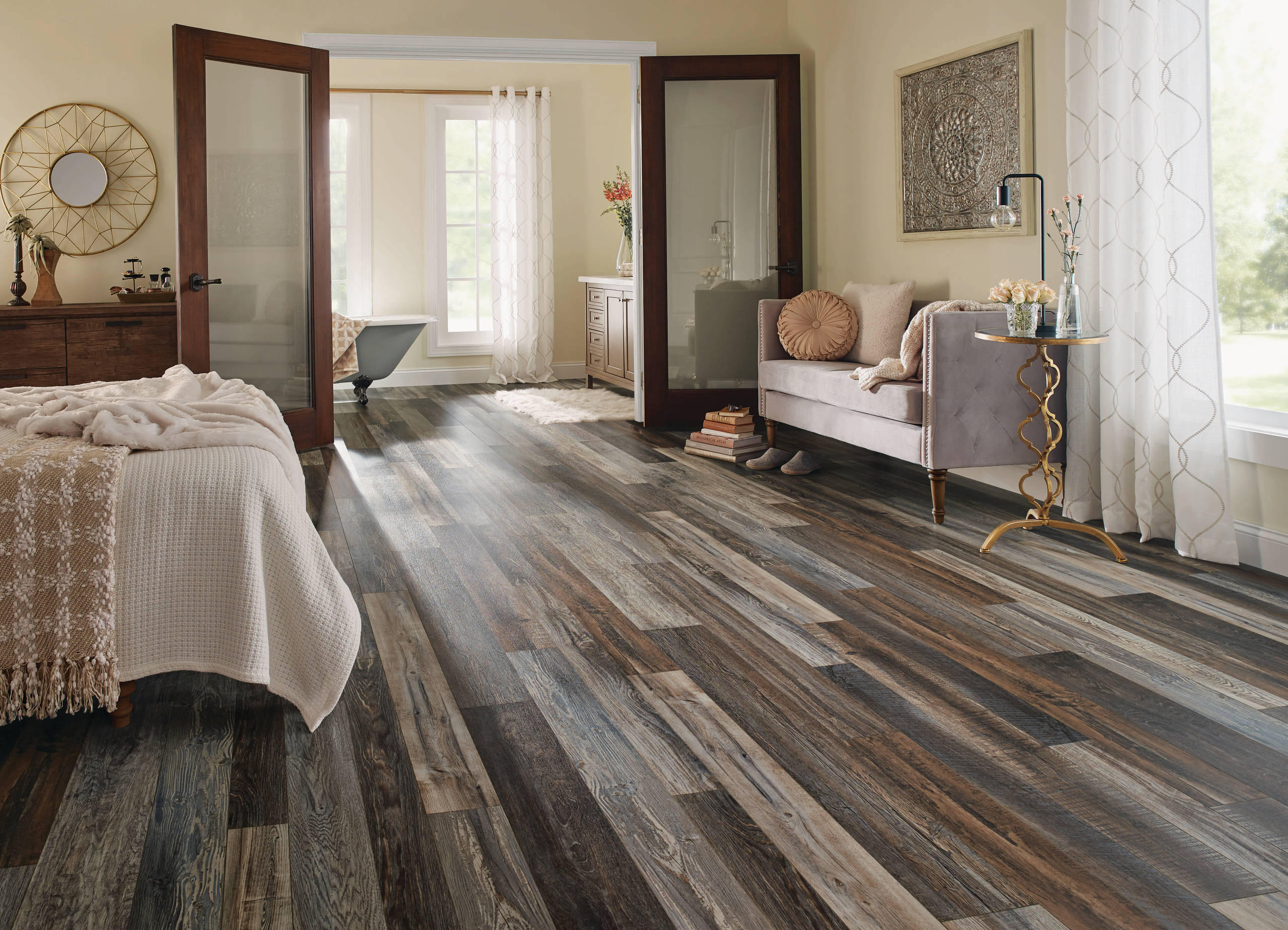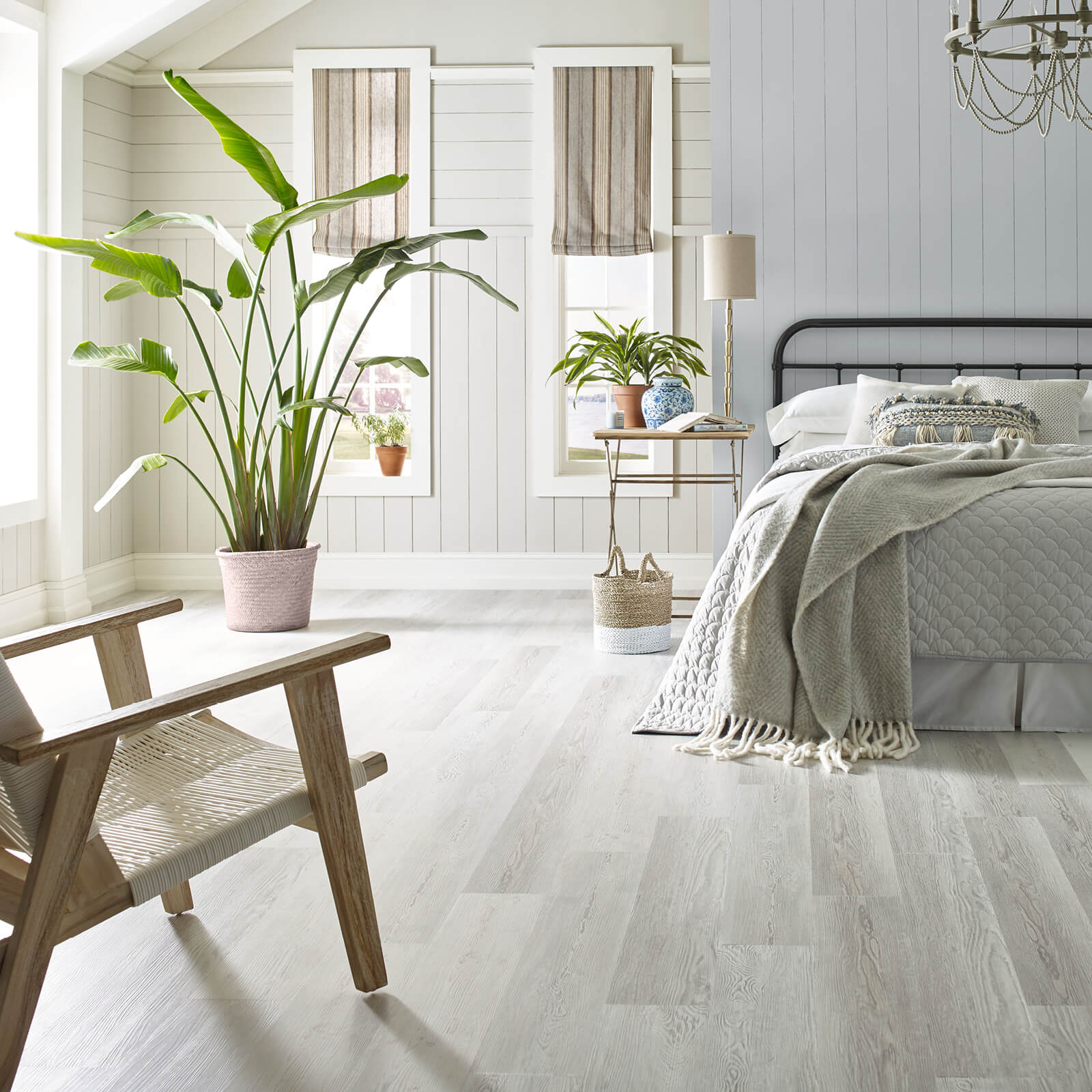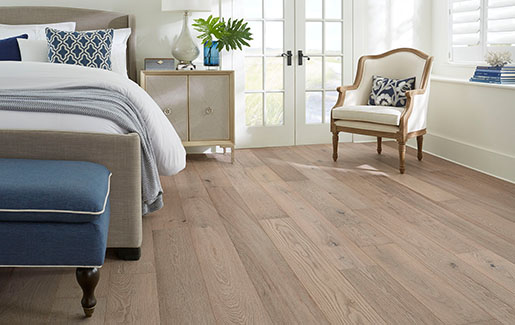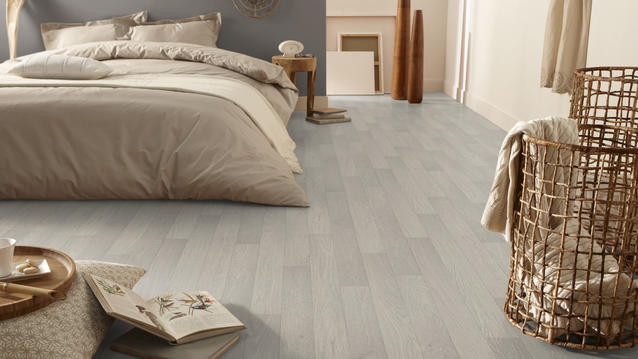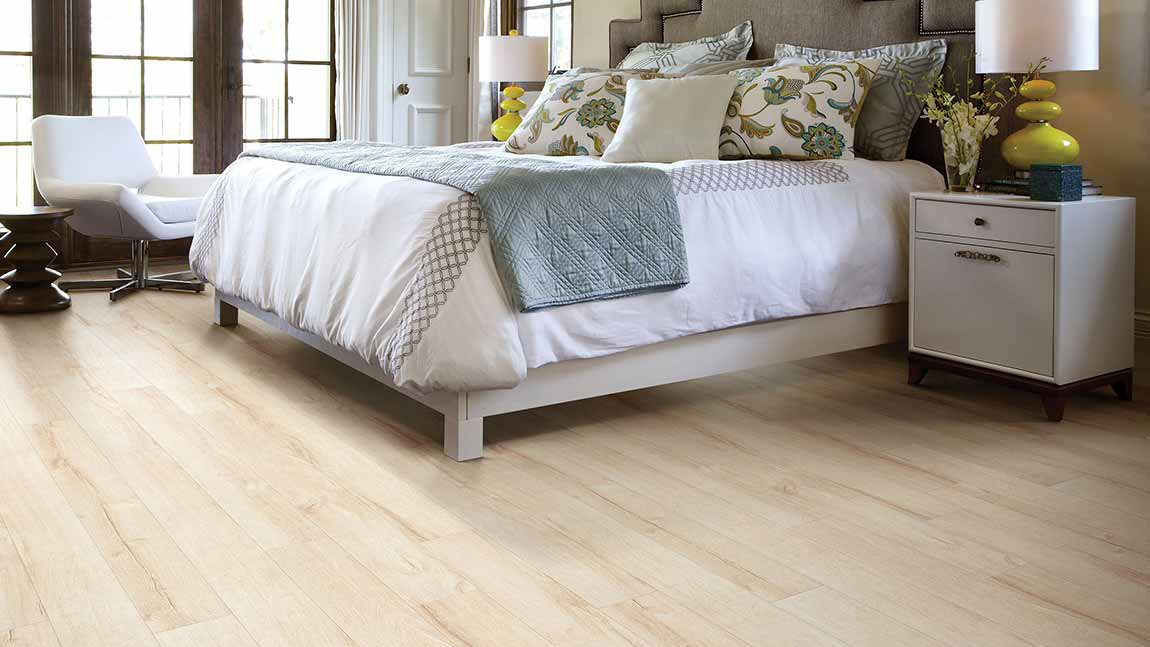Benefits of Choosing Vinyl Flooring for Bedrooms
When it comes to choosing the perfect flooring for your bedroom, vinyl often stands out as a top contender. Not only is it incredibly versatile, but it also offers a host of benefits that can make your bedroom a cozy and stylish retreat. Let’s find out why vinyl flooring is such a fantastic choice for your bedroom.
- Affordability: One of the most significant advantages of vinyl flooring is its cost-effectiveness. Compared to hardwood or tile, vinyl is much more affordable, allowing you to achieve a high-end look without breaking the bank. You can allocate those savings to other aspects of your bedroom makeover, like new furniture or decor.
- Durability and Longevity: Vinyl flooring is known for its durability. It’s designed to withstand heavy foot traffic and resist scratches, making it an excellent option for a bedroom, where you want something that can handle daily wear and tear. Plus, with proper care, vinyl flooring can last for many years, giving you great value for your investment.
- Comfort Underfoot: One of the best features of vinyl flooring is its comfort. Unlike harder surfaces like tile or hardwood, vinyl has a softer, more cushioned feel underfoot. This makes it perfect for bedrooms, where you want to create a cozy, comfortable atmosphere. Vinyl’s slight give can make standing and walking on it more comfortable for extended periods.
- Easy Maintenance: Vinyl flooring is incredibly easy to maintain. Regular sweeping and occasional mopping are usually all that’s needed to keep it looking great. Unlike carpet, vinyl doesn’t trap dust, dirt, or allergens, making it a healthier choice for those with allergies. This low-maintenance aspect is a huge plus for busy individuals or families.
- Water and Stain Resistance: Vinyl flooring is highly resistant to water and stains, making it an excellent choice for bedrooms, especially if you have kids or pets. Accidental spills or messes can be easily wiped up without worrying about permanent damage. This resistance also means you can confidently place vinyl flooring in adjacent rooms like bathrooms or laundry areas.
- Versatile Aesthetic Options: With vinyl flooring, you have a wide range of design options. From mimicking the look of natural wood or stone to more abstract patterns and vibrant colors, vinyl can suit any bedroom decor style. Whether you prefer a modern, minimalist look or a cozy, rustic feel, there’s a vinyl flooring option for you.

Types of Vinyl Flooring: Luxury, Sheet, and Plank
When considering vinyl flooring for your bedroom, it’s essential to understand the different types available. Vinyl flooring comes in three main types: luxury vinyl, sheet vinyl, and vinyl planks. Each has its unique features and benefits, making it easier to choose the one that best suits your needs.
Luxury Vinyl Flooring: Luxury vinyl flooring (LVF) is a top choice for those looking to combine beauty and durability. It comes in two forms: luxury vinyl tile (LVT) and luxury vinyl plank (LVP). LVF is designed to mimic the look of natural materials like wood or stone, providing a high-end appearance without the associated cost.
Sheet Vinyl Flooring: Sheet vinyl flooring is a continuous roll of flooring material that covers large areas seamlessly. This type of vinyl is excellent for creating a uniform look in your bedroom. It’s available in various patterns and colors, allowing you to find the perfect match for your decor.
Vinyl Plank Flooring: Vinyl plank flooring is designed to resemble hardwood planks. It’s a popular choice for bedrooms due to its realistic wood appearance and ease of installation. Vinyl planks come in various sizes and can be installed in different patterns, such as herringbone or staggered.
Installation Differences: The installation process varies between these types of vinyl flooring. Luxury vinyl flooring can be installed using a click-lock system or adhesive, making it a versatile option for DIY enthusiasts. Sheet vinyl requires careful measurement and cutting to fit the room perfectly, often necessitating professional installation. Vinyl planks, like luxury vinyl, can be installed with a click-lock system or adhesive.
Comfort and Thickness: Luxury vinyl and vinyl planks typically offer more thickness and cushioning underfoot compared to sheet vinyl. This added comfort can make a significant difference in a bedroom setting, where you want a cozy and inviting atmosphere. Thicker vinyl flooring also provides better sound insulation, which is ideal for creating a peaceful bedroom environment.
Cost Considerations: When it comes to cost, sheet vinyl is generally the most affordable option, followed by vinyl planks and then luxury vinyl. However, it’s essential to consider the long-term value. Luxury vinyl and vinyl planks often offer better durability and a more authentic appearance, making them a worthwhile investment for many homeowners.
Trendy Vinyl Flooring Designs for a Modern Bedroom
Vinyl flooring has come a long way in terms of design and aesthetics. Today, it’s possible to find trendy vinyl flooring designs that can transform your bedroom into a stylish and modern retreat. Let’s explore some of the hottest vinyl flooring trends that can elevate your bedroom’s look.
Wood-Look Vinyl Flooring
Wood-look vinyl flooring remains a top trend and for a good reason. It captures the natural beauty of hardwood while offering the durability and easy maintenance of vinyl. Whether you prefer the classic appeal of oak, the warmth of walnut, or the rustic charm of reclaimed wood, there’s a wood-look vinyl option for you.
Stone-Look Vinyl Flooring
If you love the elegance of natural stone but want a more budget-friendly and comfortable option, stone-look vinyl flooring is perfect. From the sophistication of marble to the earthy appeal of slate, stone-look vinyl can bring a touch of luxury to your bedroom without the high cost or maintenance.
Geometric Patterns
Geometric patterns are making a splash in modern bedroom design. Vinyl flooring with bold geometric shapes and designs can add a contemporary and artistic flair to your space. Think hexagons, chevrons, or intricate tile patterns that create a visually striking effect.
Textured Vinyl Flooring
Textured vinyl flooring adds depth and character to your bedroom. Embossed or hand-scraped textures can mimic the feel of real wood or stone, giving your floor a more authentic look and tactile experience. This trend is perfect for those who want their bedroom to have a unique and inviting ambiance.
High-Gloss and Matte Finishes
The finish of your vinyl flooring can significantly impact the overall look of your bedroom. High-gloss finishes provide a sleek and polished appearance, reflecting light and making the room feel more spacious. On the other hand, matte finishes offer a more understated and modern look, perfect for creating a cozy and serene bedroom environment.
Bold and Vibrant Colors
For those who love to make a statement, bold and vibrant vinyl flooring colors are a great choice. From deep navy blues and rich emerald greens to playful pinks and sunny yellows, colorful vinyl flooring can add a touch of personality and fun to your bedroom. This trend is especially popular in eclectic and contemporary design styles.
How to Choose the Right Vinyl Flooring Color and Pattern
Choosing the right color and pattern for your vinyl flooring can significantly impact the overall look and feel of your bedroom. With so many options available, it can be overwhelming to decide. Here are some tips to help you choose the perfect vinyl flooring color and pattern for your bedroom.
Consider the Room Size
The size of your bedroom plays a crucial role in determining the best flooring color. Lighter colors can make a small room appear larger and more open, while darker shades can add coziness to a spacious room. If you have a small bedroom, consider light gray, beige, or white vinyl flooring to create a more expansive feel.
Match Your Decor Style
Your bedroom’s overall decor style should guide your flooring choice. For a modern or minimalist look, opt for neutral colors and simple patterns. If your bedroom has a more traditional or rustic style, wood-look vinyl in warm tones like oak or walnut can enhance the aesthetic. For eclectic or bohemian styles, don’t be afraid to choose bold colors and unique patterns.
Think About Natural Light
The amount of natural light in your bedroom can influence how different flooring colors appear. Rooms with plenty of natural light can handle darker floors without feeling too closed in. Conversely, if your bedroom lacks natural light, lighter flooring can help brighten the space. Test samples in various lighting conditions to see how they look at different times of the day.
Balance with Wall and Furniture Colors
Your flooring should complement the colors of your walls and furniture. If you have dark walls or furniture, lighter flooring can provide a nice contrast and prevent the room from feeling too heavy. Similarly, if your bedroom features light-colored walls and furniture, darker flooring can add depth and visual interest.
Pattern and Texture
The pattern and texture of your vinyl flooring can add character to your bedroom. Wood-look patterns are timeless and versatile, while stone-look patterns can add a touch of elegance. Textured vinyl flooring, such as hand-scraped or embossed designs, can create a more realistic and tactile experience. Consider how the pattern and texture will harmonize with other elements in your room.
Personal Preference
Ultimately, your personal preference should guide your decision. Consider what colors and patterns you are naturally drawn to and what makes you feel comfortable and happy. Your bedroom is your sanctuary, so choose the flooring that reflects your taste and creates a space where you feel relaxed and at ease.
Installation Tips for Bedroom Vinyl Flooring
Installing vinyl flooring in your bedroom can be a rewarding DIY project or a job for professionals. Either way, understanding the installation process can help ensure a smooth and successful outcome. Here are some essential tips to guide you through the installation of vinyl flooring in your bedroom.
Prepare the Subfloor
Before installing vinyl flooring, it’s crucial to prepare the subfloor. Ensure it’s clean, dry, and level. Remove any old flooring, debris, and adhesive residue. If the subfloor is uneven, use a leveling compound to create a smooth surface. A well-prepared subfloor is key to a successful vinyl flooring installation.
Acclimate the Vinyl
Vinyl flooring should acclimate to the room’s temperature and humidity before installation. Lay the vinyl planks or sheets in the room for at least 48 hours to allow them to adjust. This helps prevent expansion or contraction after installation, ensuring a more stable and long-lasting floor.
Measure and Plan
Accurate measurements are essential for a precise fit. Measure the length and width of your bedroom to determine how much vinyl flooring you need. Plan the layout, starting from the center of the room and working your way out. This helps ensure a balanced and visually appealing installation.
Use the Right Tools
Having the right tools makes the installation process easier and more efficient. Basic tools you’ll need include a tape measure, utility knife, straightedge, adhesive (if required), a notched trowel, and a roller. If you’re using click-lock vinyl planks, a tapping block and rubber mallet are also helpful.
Follow Manufacturer’s Instructions
Each type of vinyl flooring may have specific installation instructions provided by the manufacturer. Follow these guidelines carefully to ensure proper installation. This includes recommended adhesive types, installation techniques, and any special precautions.
Allow for Expansion Gaps
Vinyl flooring can expand and contract with temperature changes. To prevent buckling or gaps, leave a small expansion gap around the perimeter of the room. This gap is usually covered by baseboards or trim, ensuring a clean and finished look.
Secure the Flooring
If using sheet vinyl, apply adhesive to the subfloor and carefully lay the vinyl in place, smoothing out any air bubbles. For click-lock vinyl planks, interlock the planks tightly, ensuring a secure fit. Use a roller to press the flooring firmly into place and remove any remaining air pockets.
Finishing Touches
Once the vinyl flooring is installed, add finishing touches like baseboards or trim to cover the expansion gaps and give your bedroom a polished appearance. Clean the floor to remove any adhesive residue or dust from the installation process.
Maintenance and Care for Your Vinyl Bedroom Floor
Keeping your vinyl bedroom floor in top condition is easy with regular maintenance and care. Vinyl flooring is known for its durability and low-maintenance qualities, but a little effort goes a long way in preserving its beauty and longevity. Here are some tips to help you maintain and care for your vinyl bedroom floor.
Regular Cleaning
Regular cleaning is essential to keep your vinyl floor looking its best. Sweep or vacuum the floor regularly to remove dirt, dust, and debris. Use a soft-bristle broom or a vacuum cleaner with a hard floor setting to avoid scratching the surface. Regular cleaning prevents dirt from accumulating and becoming harder to remove.
Mopping
Mop your vinyl floor occasionally to keep it clean and fresh. Use a damp mop and a mild cleaning solution specifically designed for vinyl flooring. Avoid using harsh chemicals or abrasive cleaners, as they can damage the surface. After mopping, ensure the floor is thoroughly dried to prevent water damage.
Preventing Scratches and Scuffs
While vinyl flooring is durable, it’s not immune to scratches and scuffs. Place felt pads under furniture legs to prevent scratching when moving furniture. Use area rugs or mats in high-traffic areas to protect the floor from wear and tear. Avoid dragging heavy objects across the floor, as this can cause damage.
Dealing with Spills and Stains
Vinyl flooring is resistant to stains, but it’s still important to clean up spills promptly. Use a damp cloth to wipe away spills and prevent them from seeping into the seams. For tougher stains, use a mild cleaning solution and a soft cloth. Avoid using abrasive scrubbers, as they can damage the surface.
Protecting from Sunlight
Prolonged exposure to direct sunlight can cause vinyl flooring to fade or discolor. Use curtains, blinds, or UV-protective window film to limit sunlight exposure. This helps maintain the color and appearance of your vinyl floor over time.
Regular Maintenance Checks
Perform regular maintenance checks to identify and address any issues early. Inspect the floor for signs of damage, such as loose seams or areas of wear. Address any problems promptly to prevent further damage and ensure the longevity of your vinyl flooring.
Professional Cleaning
Consider professional cleaning for your vinyl floor every few years. Professional cleaners have the tools and expertise to deep clean and restore your floor’s appearance. This can be especially beneficial if you have stubborn stains or areas of heavy wear.
Vinyl Floor Bedroom Ideas
Best Flooring for the Master Bedroom?
Choosing vinyl flooring for a bedroom
Difference Between Laminate and Vinyl Flooring
Related Posts:
